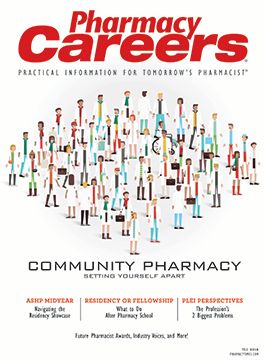Publication
Article
Pharmacy Careers
Opportunity Abounds, but Emerging Surplus of Pharmacists Means Differentiation is Key
It’s an exciting time for the profession of pharmacy, with diversity of opportunity continuing to grow dramatically as our health care system redesigns itself, slowly but surely moving from a system engineered for “sick care” encounters and mechanical throughput to one oriented toward health improvement and outcomes-based value.
It’s an exciting time for the profession of pharmacy, with diversity of opportunity continuing to grow dramatically as our health care system redesigns itself, slowly but surely moving from a system engineered for “sick care” encounters and mechanical throughput to one oriented toward health improvement and outcomes-based value.
Pharmacists are forging new value propositions and clinical niches in a system that, with every passing day, increases its awareness and appreciation for the skills they’ve accumulated over years of training and experiential learning. Reaching outward to other care team members, pharmacists have done well to position themselves as key “co-enzymes” that catalyze care processes to make them more effective (and often-times) more efficient.
The steady rise of applications for residency training over the past 2 decades indicates continued strong desire among new pharmacist graduates to continue their training, perhaps through a recognition that the job marketplace has changed. What used to be called “hire-by-license” was the threshold for job recruitment, but that has become ever more inadequate in the eyes of clinical leads and managers. A migration to “hire-by-skill-set-and-experience” mentality has taken over as the number of pharmacists with training and experience beyond the Doctor of Pharmacy degree has grown.
A Tale of 3 Decades
The move to a Doctor of Pharmacy standard across the professional schools in the 1990s caused a subtle, but important, slowdown in the growth of graduates entering the workforce at roughly the same time the health care system was beginning to experience the effects of unprecedented growth in the prevalence of chronic disease and a rapidly aging Baby Boomer generation. Simultaneously, the volume and variety of medications to treat chronic diseases expanded greatly during the1990s. As a result, at the turn of the century, we began to see unprecedented imbalances in the supply and demand for pharmacists meant to dispense medications. In most settings of care, those responsible for hiring were desperate to staff shifts. Oftentimes clinical experience, informatics acumen, and leadership skill sets were largely an afterthought for many employers struggling to staff the pharmacy. Unfilled pharmacist positions stood at 8% during the beginning of that decade, and the marketplace responded with an explosion of newly accredited schools of pharmacy at the ready to churn out new graduates in the middle and later part of the 2000s. 1,2
Meanwhile, important automation advances in central filling and electronic prescriptions, as well as third-party claims management along with a push to increase the scope of work for pharmacy technicians, were well on their way to helping reduce the order fulfillment burden on a greatly overworked pharmacist workforce.
As these advances in automation and workflow advancements occurred, reductions in third-party administration burden fell as the generic dispensing rate continued to rise dramatically, from averages in the 60% to 65% range to the 70% to 90% range when the 2010s came along.
Now in this decade, the pendulum has swung. A perfusion of new graduates are looking for work wherever they can find it (rather than dictating where they want to work) in a highly automated environment where technicians are more involved with dispensing activities than pharmacists. As a result, vacancy rates are down, with the most recently reported vacancy rate now sitting at 2% within health system pharmacy, and many areas of the country experiencing a surplus of pharmacists in all settings of care.3
But don’t fret—the upside to reduced dispensing burden and advances in automation is the freedom to provide care to patients in need. And the timing couldn’t be better. The health care system is moving to an outcomes-based marketplace that will rely on your ability to produce positive outcomes and avoid hospitalizations and other negative outcomes. You will need to differentiate yourself based on your ability to move the outcomes needle—can you deliver?
TROY TRYGSTAD, PHARMD, PHD, MBA, is vice president of Pharmacy Programs for Community Care of North Carolina (CCNC), which works collaboratively with more than 1800 medical practices to serve more than 1.6 million Medicaid, Medicare, commercially insured, and uninsured patients. He received his PharmD and MBA degrees from Drake University and a PhD in pharmaceutical outcomes and policy from the University of North Carolina. He also serves on the board of directors for the American Pharmacists Association Foundation.
References
- The adequacy of pharmacist supply: 2004 to 2030. US Department of Health and Human Services website. bhpr.hrsa.gov/healthworkforce/reports/pharmsupply20042030.pdf. Published December 2008. Accessed September 10, 2016.
- American Pharmacists Association and American Society of Health-System Pharmacists. Concerns about the accelerating expansion of pharmacy education: time for reconsideration. ASHP website. ashp.org/DocLibrary/News/Accelerating-Expansion-of-Pharmacy-Education.aspx. Accessed September 10, 2016.
- Press release. Pharmacy staffing trends for 2013 examined in ASHP report. ASHP website. ashp.org/menu/AboutUs/ForPress/PressReleases/PressRelease.aspx?id=809. Published May 16, 2014. Accessed September 14, 2016.







